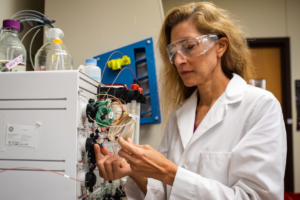Texas quietly surpassed almost all other states recently to phase out subminimum wage for individuals with a severe disability. This means certain employers can no longer obtain certificates from the Department of Labor and pay individuals with a disability as low as pennies per hour.
This is an excellent first step for our state, but it is just a first step. Now, it is time for more employers to step up and fully include all individuals in the workforce.
Championed by state Sen. Joan Huffman (R-District 17) and state Rep. John Raney (R-District 14), House Bill 885 and Senate Bill 753 were signed into law by Gov. Greg Abbott. Texas is the sixth state to pass a comparable measure. Other states and the federal government are considering similar legislation.
When Congress originally passed the Fair Labor Standards Act in 1938, it was intended to encourage the employment of individuals with a disability, but instead it has contributed to greater isolation and sustained a cycle of poverty.
Most people who were placed in sheltered workshops and never transitioned to typical employment environments. One of the reasons that subminimum wage is ineffective is that it does not encourage people to pursue jobs that use their individual strengths. The entire existence of sheltered work and subminimum wage is predicated on the idea that disabled people cannot succeed in employment.
But the data shows this is not true.
In the United States alone, more than 50 million individuals have some kind of disability. About 1 million live with a severe disability, and 2 million have a functional limitation.
According to the U.S. Census Bureau, 41% of individuals with a disability were a part of the workforce, compared with 79% of those without a disability. The poverty rate for working-age people with disabilities is nearly 2½ times as high as that for people without disabilities.
And recent research finds that half of working-age adults who experience at least one year of poverty have a disability, and nearly two-thirds of those experiencing longer-term poverty have a disability.
New government programs have started to create pathways for people with disabilities to enter or return to the workforce, such as the Ticket to Work program, which gives people on Social Security a trial work period where they can be employed for several months without losing benefits and deduct disability expenses from their countable income.
But it is ultimately up to employers which would make the biggest impact. The U.S. Chamber of Commerce has reported that hiring individuals who have disabilities is good for the bottom line.
Many studies have shown that people with disabilities take fewer absent days, and that they are more likely to stay on the job longer than nondisabled workers. Fortune magazine currently rates Texas as having the 18th best state employment rate for people with disabilities.
But Texas has a way to go. Texas’ employment rate for adults with disabilities is 38.6%, compared with 57.1% in Wyoming, which has the highest employment rate for people with disabilities.
Moving forward, Texas lawmakers should focus on communicating a state-level commitment to employment access for those with disabilities. This easily can be completed by the governor’s office and other elected officials publicly discussing the importance of employment access to individuals with disabilities, and through promoting innovative employers in the media.
Second, steps should be taken to reduce barriers to employment entrance for young adults with disabilities. Many young adults who are able to work but have a disability are instructed to apply for supplemental security income to ensure they can continue to receive medical and psychiatric care.
By continuing to provide Medicaid to young adults until age 26 instead of stopping at age 18, there will be a reduced incentive to pursue supplemental security income instead of entering the workforce.
Great progress has been made, but if Texas really wants to get serious, we need to make more changes.
Deborah Cohen is a research assistant professor in the Steve Hicks School of Social Work and the Dell Medical School at The University of Texas at Austin. She is also the mother of a child who has Down syndrome.
A version of this op-ed appeared in the Austin American Statesman and the Waco Tribune Herald.




